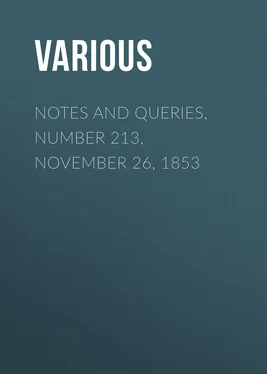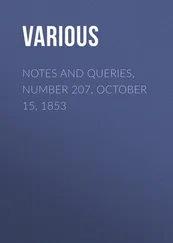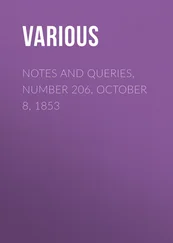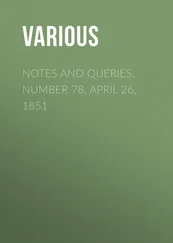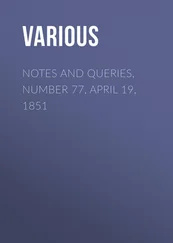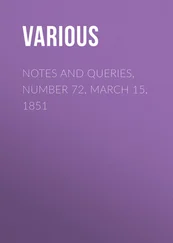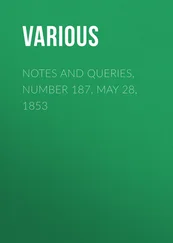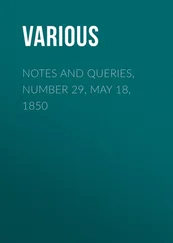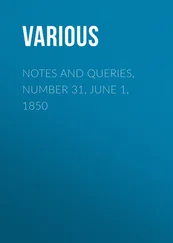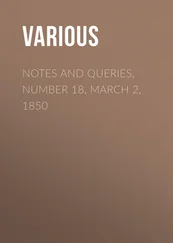Various - Notes and Queries, Number 213, November 26, 1853
Здесь есть возможность читать онлайн «Various - Notes and Queries, Number 213, November 26, 1853» — ознакомительный отрывок электронной книги совершенно бесплатно, а после прочтения отрывка купить полную версию. В некоторых случаях можно слушать аудио, скачать через торрент в формате fb2 и присутствует краткое содержание. Жанр: foreign_antique, periodic, foreign_edu, на английском языке. Описание произведения, (предисловие) а так же отзывы посетителей доступны на портале библиотеки ЛибКат.
- Название:Notes and Queries, Number 213, November 26, 1853
- Автор:
- Жанр:
- Год:неизвестен
- ISBN:нет данных
- Рейтинг книги:4 / 5. Голосов: 1
-
Избранное:Добавить в избранное
- Отзывы:
-
Ваша оценка:
- 80
- 1
- 2
- 3
- 4
- 5
Notes and Queries, Number 213, November 26, 1853: краткое содержание, описание и аннотация
Предлагаем к чтению аннотацию, описание, краткое содержание или предисловие (зависит от того, что написал сам автор книги «Notes and Queries, Number 213, November 26, 1853»). Если вы не нашли необходимую информацию о книге — напишите в комментариях, мы постараемся отыскать её.
Notes and Queries, Number 213, November 26, 1853 — читать онлайн ознакомительный отрывок
Ниже представлен текст книги, разбитый по страницам. Система сохранения места последней прочитанной страницы, позволяет с удобством читать онлайн бесплатно книгу «Notes and Queries, Number 213, November 26, 1853», без необходимости каждый раз заново искать на чём Вы остановились. Поставьте закладку, и сможете в любой момент перейти на страницу, на которой закончили чтение.
Интервал:
Закладка:
Various
Notes and Queries, Number 213, November 26, 1853 / A Medium of Inter-communication for Literary Men, Artists, Antiquaries, Genealogists, etc
Notes
THE STATE PRISON IN THE TOWER
A paragraph has lately gone the round of the newspapers, in which, after mentioning the alterations recently made in the Beauchamp Tower and the opening of its "written walls" to public inspection, it is stated that this Tower was formerly the place of confinement for state prisoners, and that "Sir William Wallace and Queen Anne Boleyn" were amongst its inmates.
Now, I believe there is no historical authority for saying that "the Scottish hero" was ever confined in the Tower of London; and it seems certain that the unfortunate queen was a prisoner in the royal apartments, which were in a different part of the fortress. But so many illustrious persons are known to have been confined in the Beauchamp Tower, and its walls preserve so many curious inscriptions—the undoubted autographs of many of its unfortunate tenants—that it must always possess great interest.
Speaking from memory, I cannot say whether the building known as the Beauchamp (or Wakefield) Tower was even in existence in the time of Edward I.; but my impression is, that its architecture is not of so early a time. It is, I believe, supposed to derive its name from the confinement in it of Thomas de Beauchamp, Earl of Warwick, in 1397. Of course it was not the only place of durance of state prisoners, but it was the prison of most of the victims of Tudor cruelty who were confined in the Tower of London; and the walls of the principal chamber which is on the first storey, and was, until lately, used as a mess-room for the officers, are covered in some parts with those curious inscriptions by prisoners which were first described in a paper read before the Society of Antiquaries in 1796, by the Rev. J. Brand, and published in the thirteenth volume of The Archæologia .
Mr. P. Cunningham, in his excellent Handbook , says:
"William Wallace was lodged as a prisoner on his first arrival in London in the house of William de Leyre, a citizen, in the parish of All Hallows Staining, at the end of Fenchurch Street."
Mr. Cunningham, in his notice of the Tower, mentions Wallace first among the eminent persons who have been confined there. The popular accounts of the Tower do the like. It was about the Feast of the Assumption (Aug. 15) that Wallace was taken and conducted to London; and it seems clear that he was forthwith imprisoned in the citizen's house:
"He was lodged," says Stow, "in the house of William Delect, a citizen of London, in Fenchurch Street. On the morrow, being the eve of St. Bartholomew (23rd Aug.), he was brought on horseback to Westminster … the mayor, sheriffs, and aldermen of London accompanying him; and in the Great Hall at Westminster … being impeached," &c.
The authorities cited are, Adam Merimuth and Thomas de La More. His arraignment and condemnation on the Vigil of St. Bartholomew are also mentioned by Matthew Westminster, p. 451. Neither these historians, or Stow or Holinshed, afford any farther information. The latter chronicler says that Wallace was "condemned, and thereupon hanged" ( Chron. , fol., 1586, vol. ii. p. 313.). He was executed at Smithfield; and it is not improbable that, if, after his condemnation, he was taken to any place of safe custody, he was lodged in Newgate. The following entry of the expenses of the sheriffs attending his execution is on the Chancellor's Roll of 33 Edw. I. in the British Museum:
"Et in expens t misis fcis  eosđ Vice tes Willo le Walleys Scoto lat one predone puplico utlagato inimico et rebellione
eosđ Vice tes Willo le Walleys Scoto lat one predone puplico utlagato inimico et rebellione  qui in contemptu
qui in contemptu 
 Scociam se Regem Scocie falso fecāt nōiare t t ministros in tībus Scocie intfecit at
Scociam se Regem Scocie falso fecāt nōiare t t ministros in tībus Scocie intfecit at  dux texcercitū hostilit contr aRegē
dux texcercitū hostilit contr aRegē  judiciū Cur
judiciū Cur  apud Westm dist ahendo suspendendo decollando ej viscera concremando ac ej corpus q arterando cuj cor is quartia ad iiij majores villas Scocie t asmittebantur hoc anno.... £ xj s. x d. "
apud Westm dist ahendo suspendendo decollando ej viscera concremando ac ej corpus q arterando cuj cor is quartia ad iiij majores villas Scocie t asmittebantur hoc anno.... £ xj s. x d. "
The day of the trial, August 23, is generally given the date of his execution. It therefore appears that the formidable Scot never was a prisoner in the Tower.
The unfortunate Queen Anne Boleyn occupied the royal apartments while she was a prisoner in the Tower. From Speed's narrative, it appears that she continued to occupy them after she was condemned to death. On May 15 (1536) she was (says Stow)
"Arraigned in the Tower on a scaffold made for the purpose in the King's Hall; and after her condemnation, she was conveyed to ward again, the Lady Kingston, and the Lady Boloigne her aunt, attending on her."
On May 19, the unfortunate queen was led forth to "the green by the White Tower" and beheaded.
In the record of her trial before the Duke of Norfolk, Lord High Steward (see Report of Deputy Keeper of Public Records ), she is ordered to be taken back to "the king's prison within the Tower;" but these are words of form. The oral tradition cannot in this case be relied upon, for it pointed out the Martin Tower as the place of her imprisonment because, as I believe, her name was found rudely inscribed upon the wall. The Beauchamp Tower seems to have been named only because it was the ordinary state prison at the time. The narrative quoted by Speed shows, however, that the place of her imprisonment was the queen's lodging, where the fading honours of royalty still surrounded Anne Boleyn.
William Sidney Gibson.Newcastle-upon-Tyne.
INEDITED LETTER FROM HENRY VIII. OF ENGLAND TO JAMES V. OF SCOTLAND
I lately transcribed several very interesting original manuscripts, chiefly of the seventeenth century, but some of an earlier date, and now send you a literal specimen of one evidently belonging to the sixteenth century; although, notwithstanding the day of the month is given, the year is not. If you think it worthy of a place in your very excellent publication, you are quite at liberty to make use of it, and I shall be happy to send you some of the others, if you choose to accept them. They chiefly relate to the period when the Duke of Lauderdale was commissioner for Scotch affairs at the English Court; and one appears to be a letter addressed by the members of the Scottish College at Paris to James I. on the death of his mother.
Thos. Nimmo.Right excellent right high and mighty prince, our most dereste brother and nephew, we recommende us unto you in our most hertee and affectuous maner by this berer, your familyar servitor, David Wood. We have not only receyved your most loving and kinde let sdeclaring how moch ye tendre and regarde the conservation and mayntennance of good amytie betwene us, roted and grounded as well in proximitie of blood as in the good offices, actes, and doyngs shewed in our partie, whiche ye to our greate comforte afferme and confesse to be daylly more and more in your consideration and remembraunce (but also two caste of fair haukes, whiche presented in your name and sent by youe we take in most thankfull parte), and give youe our most hertie thanks for the same, taking greate comforte and consolacion to perceyve and understande by your said letters, and the credence comitted to your said familyar servitor David Wood, which we have redd and considered (and also send unto youe with these our letters answer unto the same) that ye like a good and uertuous prince, have somoche to herte and mynde the god rule and order uppon the borders (with redresse and reformacion of such attemptats as have been comytted and done in the same), not doubting but if ye for your partie as we intende for ours (doe effectually persiste and contynue in so good and uertuose purpose and intente), not only our realmes and subjectts shall lyue quyetly and peasably without occasion of breche, but also we their heddes and gouernors shall so encrease and augment our syncere love and affecōn as shall be to the indissoluble assurammente of good peace and suretie to the inestimable benefit, wealth, and comoditie of us our realmes and subjectts hereafter.
Читать дальшеИнтервал:
Закладка:
Похожие книги на «Notes and Queries, Number 213, November 26, 1853»
Представляем Вашему вниманию похожие книги на «Notes and Queries, Number 213, November 26, 1853» списком для выбора. Мы отобрали схожую по названию и смыслу литературу в надежде предоставить читателям больше вариантов отыскать новые, интересные, ещё непрочитанные произведения.
Обсуждение, отзывы о книге «Notes and Queries, Number 213, November 26, 1853» и просто собственные мнения читателей. Оставьте ваши комментарии, напишите, что Вы думаете о произведении, его смысле или главных героях. Укажите что конкретно понравилось, а что нет, и почему Вы так считаете.
